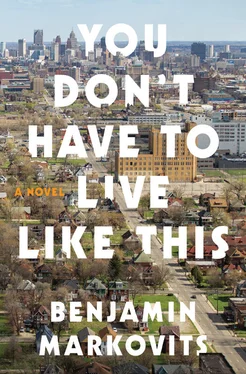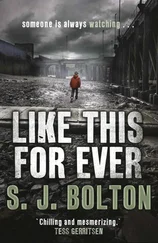“I hope not.” This was an example of his humor — not so much funny as hard to read.
Later he delivered one of his prepared speeches. The reason I brought you in on this, he said, is not just because it was your idea in the first place. “I wanted a historian on hand, in case this thing takes off. I want you to write about it.”
There were plenty of journalists around, interviewing him and Clay and covering the story for newspapers and magazines. Smart guys, some of them, but they weren’t his guys; also, it wasn’t their job to take the long view. Then he spoke about my academic specialty, American colonial history — he’d been reading up on that, too. It’s an obvious point, he said, but what people forget about the early settlers is that they were shipped over by private companies; it was a business venture. A typical Robert James pronouncement, vaguely general and matter-of-fact. He believed that what we were doing in Detroit belonged to the same tradition.
I said, “It means a lot for me to be here. I was going out of my mind in Baton Rouge.”
“You’re one of those crazy guys who isn’t meant to be alone,” Robert told me, tapping the code into the front gate.
That afternoon he flew to Boston, and from there he went on to Geneva and then Hong Kong. A few weeks later I got a peek at his Detroit diary, which Beatrice was in charge of. Flipping through the pages I caught sight of my name. “Take a walk with Marny after breakfast,” it said, under the date.
But even at the time I felt stage-managed. I had opened up to him, in confidence, and he had taken advantage of my confession to give me his opinion. So now I was stuck with it. You don’t often get a sense of what people think of you. And the worst thing about sexual loneliness is that you have no practical and tedious duties and arguments to occupy the hamster wheels in your brain. So this kind of thing goes around and around.
TONY LIKED TO SNARK ABOUT Clay and Robert James and the rest, the whole setup. He showed me around Detroit, starting with the big art deco towers downtown — arched halls, mosaics on the walls and floors, gold leaf. It was like walking around the pyramids, they were monuments, not offices, half dead, except for the tourists, and even the ugly new buildings surrounding them had space for rent signs hanging from the thirtieth-floor windows. You could park downtown, there was plenty of room, and every time a People Mover, one of those funny sky trains, passed overhead, Tony pointed and shouted and tried to see if there was anyone in it.
“This was a fucking great city,” he said, “when LA was just a small town. And the only thing left is four lousy ball clubs.”
We broke into Michigan Central Station together, which reminded me of Sterling Library at Yale. Gravestone architecture, a tall narrow gray slab. Except instead of books it was full of broken glass, wires, loose stones, graffiti, cigarette butts and beer bottles. Like most abandoned places it showed funny intimate signs of habitation: underpants, a can of shaving foam. I cut my hand on the chain-link fence surrounding it and for weeks afterwards had to resist scratching the scab. We went round the ballparks and the fine arts museum and wandered through the asbestos-lined hallways of an old factory, where the radiators seethed and dripped. Artists had taken over the place and filled it with bad watercolors and large lumpy ceramics. We ate Polish food in Hamtramck.
The house itself was full of journalists, politicians, lawyers, academics and other hangers-on. A documentary crew filmed many of our meetings and sometimes followed us around the city in several cars, recording. Clay Greene was going to present. You couldn’t tell how old he was, that was part of his appeal. Clay was one of these smooth-skinned good-looking guys who might be prematurely gray or well preserved. This was his first venture into TV, which accounted for some of his personal vanity. The mirrors around him were multiplying, and when he opened his mouth the tape recorder clicked on.
Sometimes, after dinner, we watched the outtakes in Robert’s home cinema. There was Clay on the wall, spread out on a flat white roll of screen, and Clay sitting beside me, and both of them were talking, explaining.
Detroit seemed to him a textbook case of the need for private-public partnerships. Most people assumed that the failure of state and market forces meant that Detroit itself was doomed. Urban studies theorists like Richard Florida suggested abandoning the Rust Belt altogether. But Clay believed that a highly directed combination of the two could solve many of its problems. He was very interested in China. The Chinese had been trying to combine free market capitalism with democratic centralism for several years, and had managed to regenerate a number of cities in much worse shape than Detroit. Of course, the government took on a lot of short-term debt. You needed someone willing to play God, or king.
This, as Clay liked to say, was Robert’s job.
He had a dry, cordial host-at-a-cocktail-party TV manner, which wasn’t entirely humorless. Let me introduce you to a few ideas, very dear friends of mine.
“This city,” he said, posing for the cameras in front of Michigan Central Station, in his tasseled loafers and holding lightly onto his linen tie, to keep the wind from blowing it in his face, “lies at the center of so much of what America is talking about and worrying about today: the death of the middle class and the rise of social inequality, the collapse of the real estate market and the decline of manufacturing, the failure of the American labor movement and the entrenchment, almost fifty years after Martin Luther King led the March on Washington for Jobs and Freedom, of a black underclass. Detroit at its peak had a population of almost two million people — it is now roughly a third of that, which means, let me put it this way, that for every family still living here, their neighbors on either side of them have moved away. And their houses — you can see this for yourself because we’re going to show them to you — sit either empty or boarded up, or half burned down, or they’ve been destroyed altogether, and grass and trees are growing in their place. What we are about to witness is a small experiment in regeneration — an attempt to repopulate these neighborhoods, to rebuild these houses, to revive these communities. It is, by its nature, a very local solution to some of the deeper and broader problems America faces today. But if you can fix it here, you can fix it anywhere.”
In practice what all this meant is that Robert and a consortium of investors were buying up a section of the city — about two thousand houses, six hundred acres’ worth of empty plots and a handful of derelict industrial sites. A few hundred homeowners refused to sell. Even a landgrab like this was small potatoes compared to the scale of the problem. Part of what’s wrong with Detroit is that it’s too big. Physically, I mean. Almost 140 square miles big. So five square miles don’t add up to much. At best Robert hoped to add ten thousand economically active residents to a city that had lost almost a million in the last forty years. Which is why the business model needed to be profitable, so that it could be reproduced in Cleveland, Buffalo, Erie, Milwaukee, East Baltimore, etc.
The consortium planned to rent out the houses, business units, and land very cheaply, not just to individuals but also to groups of people who would organize themselves over the Internet and put in bids. Starting-from-Scratch-in-America was the name of the site — it showed houses and plots of land like an airline check-in chart. Of course, part of what he was selling was just the organizational tools. People who wanted to start over might hesitate to go it alone. But if they stayed long enough, and the neighborhood went up, they also got a share of the profit. That was the other part of the deal, a right-to-buy scheme.
Читать дальше












